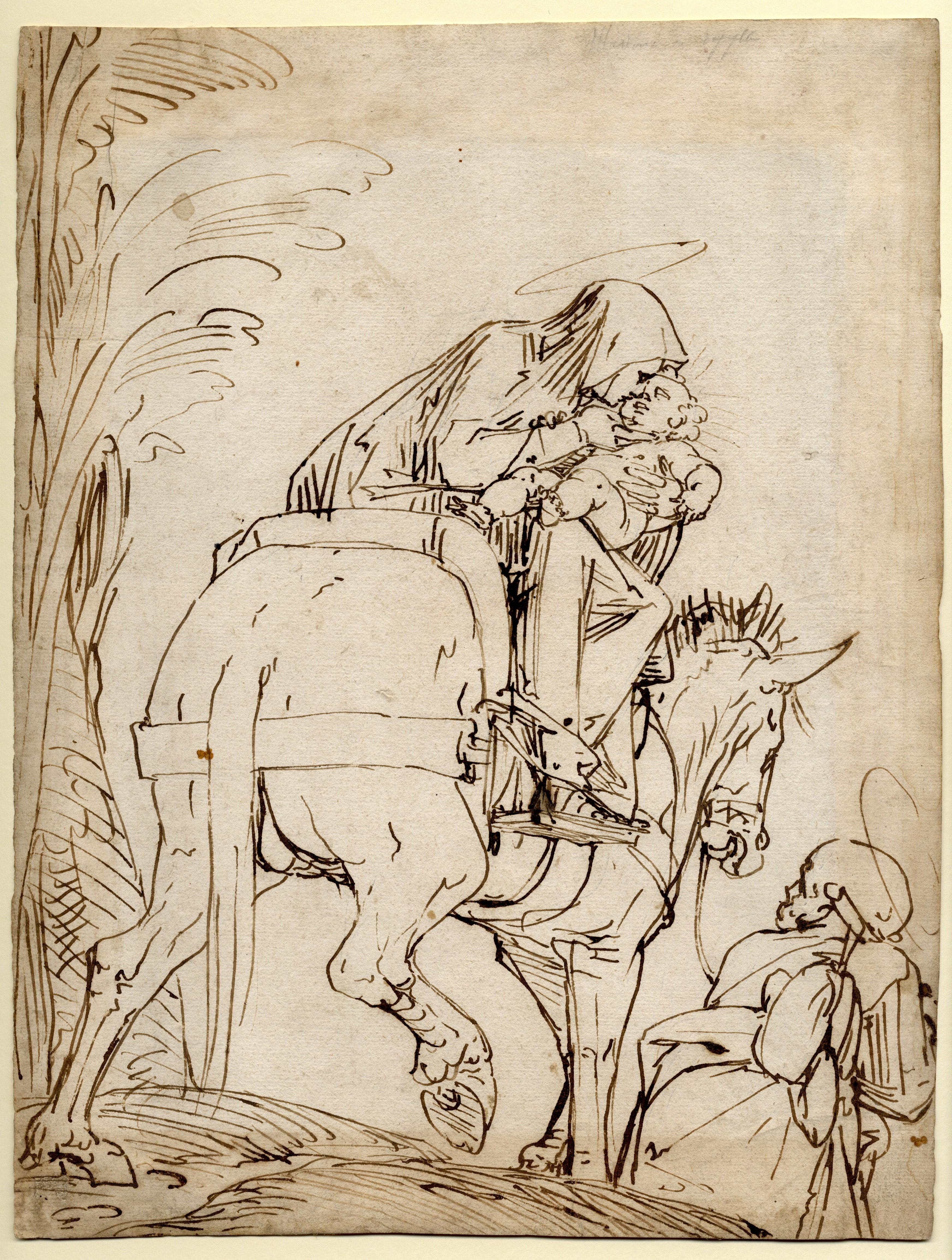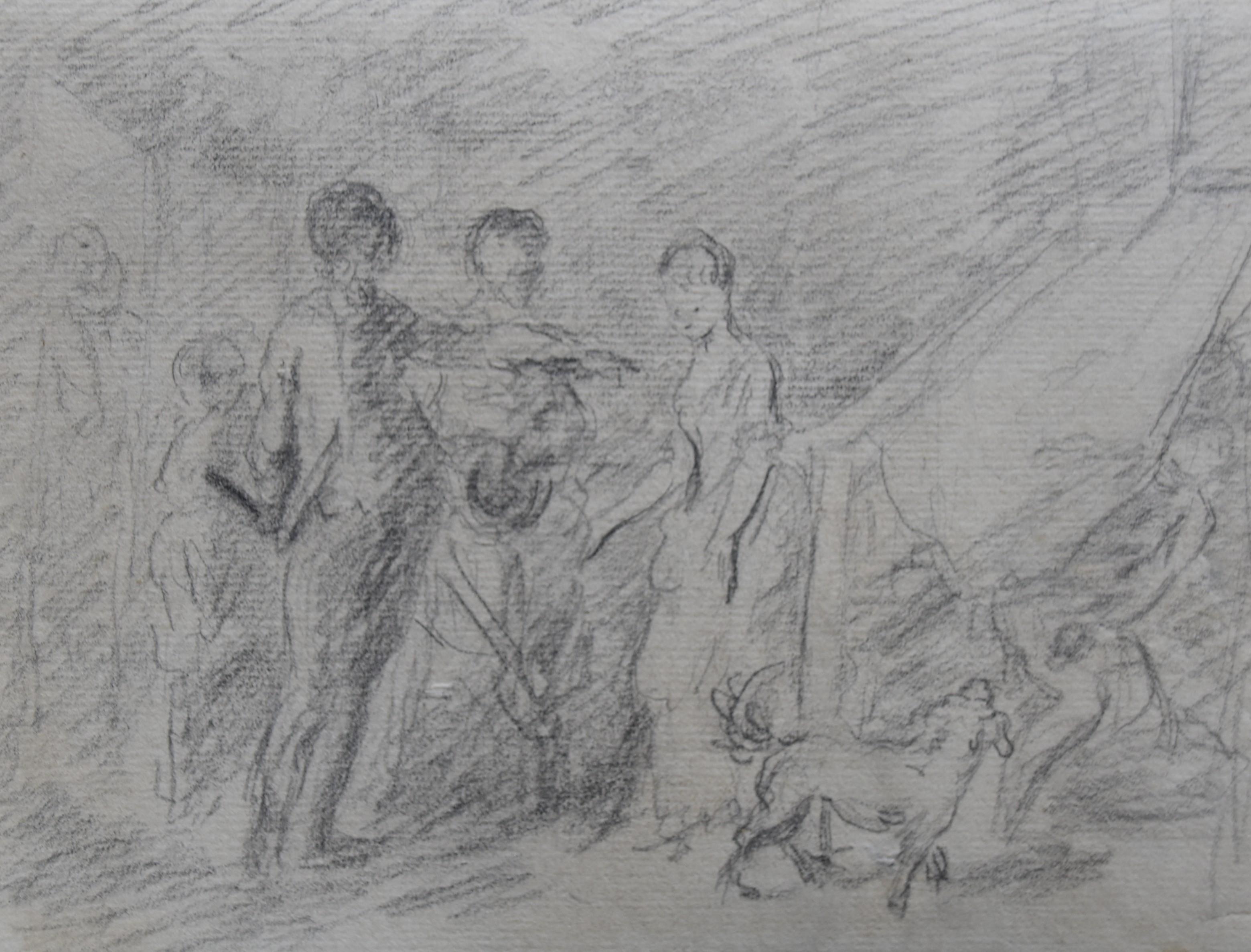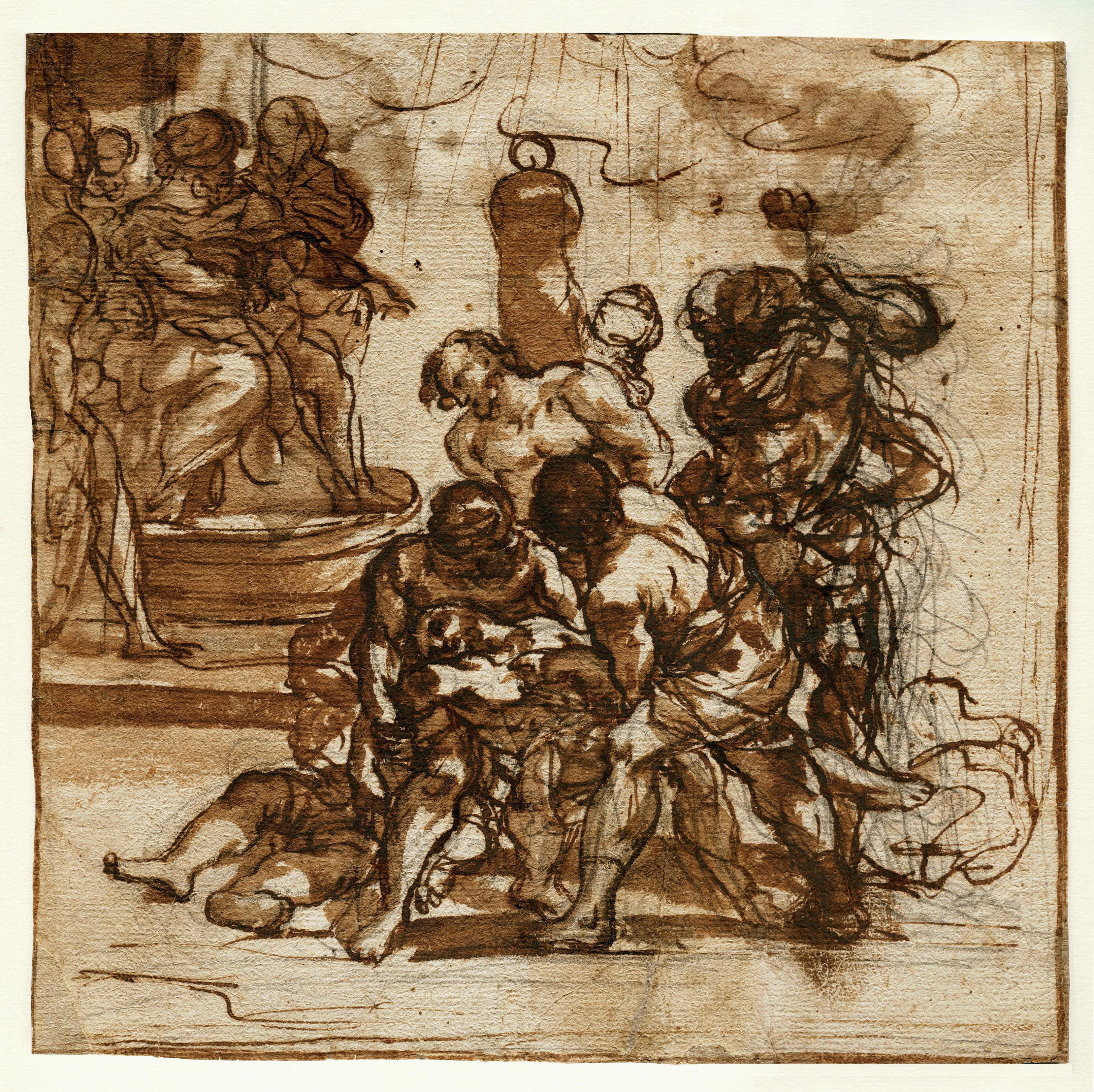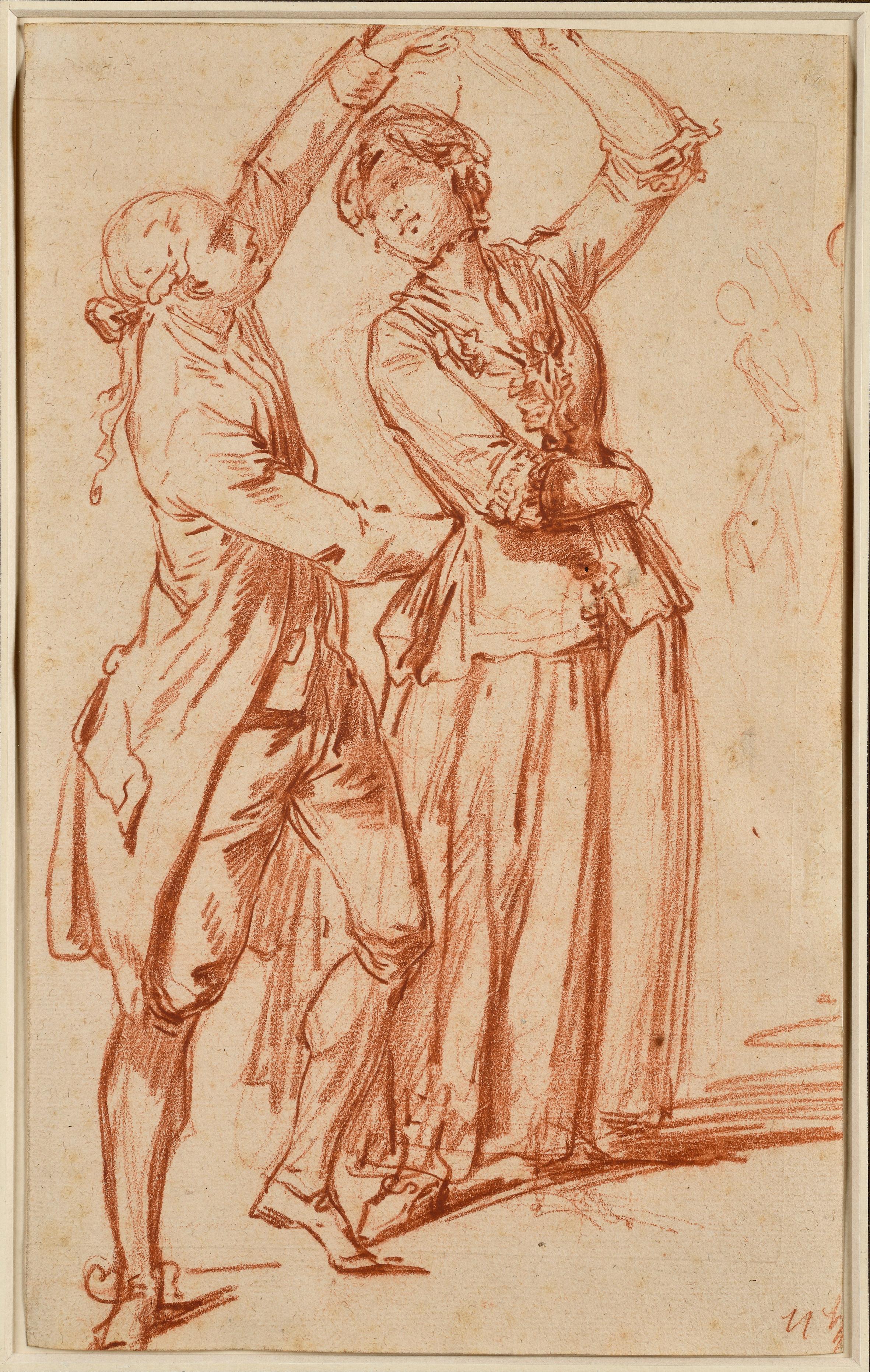Items Similar to Soldier begging for Mercy a preparatory study by Jean-Marc Nattier (1685 - 1766)
Want more images or videos?
Request additional images or videos from the seller
1 of 10
Jean-Marc NattierSoldier begging for Mercy a preparatory study by Jean-Marc Nattier (1685 - 1766)1717
1717
About the Item
This rare drawing by Nattier is part of a set of preparatory studies executed in 1717 for one of the painter's first commissions, the painting commissioned by Tsar Peter I of Russia to celebrate his victory over the Swedes at Poltava in Ukraine on July, 8th 1709. Kept in Nattier's studio (he did not paint any other battle scenes), these studies were later used to decorate the background of military portraits depicting battles.
1. Peter I of Russia, one of Nattier's first patrons
Jean-Marc Nattier was born in Paris in 1685 into a family of artists: his father Marc was also a portraitist and his mother Marie Courtois was a miniaturist, his brother Jean-Baptiste was also a painter.
Gifted with a very precocious talent, he won first prize for drawing at the Academy at the age of fifteen. Although his godfather, the painter Jean Jouvenet (1644 - 1717), gave him the opportunity to go to the French Academy in Rome, he preferred to stay in Paris and made drawings of the paintings by Rubens in the famous Luxembourg Palace gallery commissioned by Marie de Médicis. He was then admitted to the Académie in 1713 and became a full member in 1718.
In 1716, an envoy of the Russian Tsar Peter I convinced him to go to Amsterdam, while the Tsar was visiting, and then follow him to Russia. When in Holland, he painted a portrait of Peter I’s wife, the future Empress Catherine II, and a painting representing the Battle of Poltava. Nattier preferred to return to Paris than to follow the Tsar to Russia, but he did paint his portrait between May and June 1717 during the latter's visit to Paris.
Nattier then became the portraitist of the Orleans family and, from 1748 onwards, of the Court of Louis XV. He died in 1766 ill and destitute, shunned by the public after having enjoyed extraordinary success as a portraitist during his mature years.
2. The Victory of Poltava, a major painting with a rich body of preparatory studies
Peter I, better known as Peter the Great, was born on 30 May 1672 in Moscow and died on 28 January 1725 in St Petersburg. He became Tsar of Russia in 1682 and received the title of Emperor of all the Russias in 1721, at the conclusion of the Great Northern War (1700-1721) opposing Russia to the Swedish Empire of Charles XII, of which the victory of Poltava (now in Ukraine) in 1709 was a decisive turning point.
Nattier's composition (4th photo in the Gallery) during his stay in Amsterdam in 1717 presents an imaginary view of this battle in which the painter does not attempt to render the specificity of the place, but rather translates the confusion of the battle between the Russian army (in green uniforms) and the Swedish army (in blue uniforms).
Nattier took particular care in the preparation of this work, drawing a study for each of the soldiers involved in the battle. The drawing we are presenting is one of five known studies , the other four represent:
• a study of an officer wearing a tricorn (a preparatory sketch for the figure of the Tsar - last photo of the gallery);
• a study of a rider (for the rider on the left of the Tsar);
• a study for the soldier wielding the bayonet rifle in the centre of the painting,
• a study for the Russian soldier lying under the white horse in the centre of the painting.
Although our drawing is unusual in that it was not used in the final composition, its execution by Nattier was recognised by Xavier Salmon , the author of the catalogue of the Versailles exhibition (where the Calvet Museum drawing was displayed).
While the Victory of Poltava is the only battle scene the painter painted, these studies constituted a portfolio which the painter used throughout his career to decorate the background of his military portraits.
3. Description of the artwork
This drawing represents a soldier on the ground, leaning on his left elbow and raising his right arm, begging for mercy. It is vigorously executed and organised around two diagonals that cross at the level of the soldier's chest: that of his arms, extended by his open hands as a sign of abandonment and despair, and that of the reverse of our soldier's jacket, extended by the arch of his nose.
While the shadow cast on the ground by the soldier adds a dramatic dimension to the scene, the few strokes of white chalk enliven the drawing and poignantly underline the character's immense vulnerability: the hands, the uncovered face with its imploring mouth, the belt that seems to have broken in his fall.
We have chosen to frame this drawing with Bérain rods dating from the first quarter of the 18th century, which were supplied to us by the Maison Lebrun.
Main bibliographical references :
Le dessin français au XVIIIe siècle Louis-Antoine Prat Edition Musée du Louvre/ Somogy éditions d'art March 2017
Jean-Marc Nattier Xavier Salmon - Réunion des Musées Nationaux, Paris 1999
- Creator:Jean-Marc Nattier (1685 - 1766, French)
- Creation Year:1717
- Dimensions:Height: 15 in (38.1 cm)Width: 13.38 in (33.99 cm)
- Medium:
- Movement & Style:
- Period:1710-1719
- Condition:9 7/16” x 7 7/8” (24 x 20 cm) - Framed 15” x 13 3/8” (38 x 34 cm) Provenance: this drawing remained in Nattier's studio until his death. It was then acquired by the Parrocel family and sold by their descendants in 1983.
- Gallery Location:PARIS, FR
- Reference Number:1stDibs: LU1568213229972
About the Seller
5.0
Vetted Seller
These experienced sellers undergo a comprehensive evaluation by our team of in-house experts.
Established in 2020
1stDibs seller since 2021
8 sales on 1stDibs
Typical response time: 2 hours
- ShippingRetrieving quote...Ships From: PARIS, France
- Return PolicyA return for this item may be initiated within 3 days of delivery.
More From This SellerView All
- A red chalk study sheet by Baldassare Franceschini, known as VolterranoLocated in PARIS, FRThis fresh sanguine sheet presents various studies placed next to each other in no apparent order. Two of the feet studies are preparatory to the first major commission received by the young Baldassare Franceschini, shortly after his installation in Florence, the frescoes for the Medici Fastes. This cycle was executed between 1636 and 1646 for the Villa La Petraia, a Medici villa on the outskirts of Florence, which allows us to date this sheet to the artist's youth. 1. The Medici Fastes, the first major commission for a young artist Born in Volterra in 1611, the town from which he took his nickname, Baldassare Franceschini apprenticed with his father, a sculptor of alabaster, one of his home town's specialities, and studied with Cosimo Daddi (1540-1630), a local artist. The Marquis Inghirami, who spotted his talent, sent him to the workshop of Matteo Rosselli (1578 - 1650) in Florence, which was also attended by Francesco Furini (1603 - 1646). In 1636, Lorenzo de' Medici, the youngest son of Ferdinand Ier and Christine of Lorraine, chose the 25-year-old artist, again on the advice of the Marquis Inghirami, to decorate with frescoes the loggias of the inner courtyard of the Villa La Petraia, which he had just inherited on the death of his mother. The project lasted about ten years and included ten scenes placed symmetrically in two loggias on either side of the courtyard: four main scenes and six placed above the doors, each to the glory of a member of the Medici family. This decoration was his major secular project, but Volterrano also executed several religious frescoes and a few easel paintings, often with less success. Among the religious commissions, we can cite the dome of the Colloredo chapel dedicated to Saint Lucy...Category
Mid-17th Century Old Masters Figurative Drawings and Watercolors
MaterialsChalk, Paper
- Study of a Fate at mid-body, a red chalk attributed to Giovanni da San GiovanniLocated in PARIS, FRThis spectacular red chalk drawing depicts an elderly woman, her eyes bulging, her hand stretched out towards the sky. This disturbing character, who seems close to dementia, and the elongation of her arm with its Mannerist overtones, plunge us into the Florentine artistic milieu of the first half of the 17th century. The proximity of this drawing to some characters in the fresco in the Pitti Palace representing The Muses, Poets and Philosophers chased from Parnassus, the last masterpiece of Giovanni da San Giovanni, leads us to propose an attribution to this artist and a dating of around 1635-1636. 1. Giovanni da San Giovanni, the painter of contradiction We take here the title of the monography dedicated to the artist by Anna Banti in 1977, which remains the reference book for this artist. The son of a notary, Giovanni Mannozzi, known as Giovanni da San Giovanni, abandoned his studies to go to Florence at the age of sixteen, where he entered the studio of Matteo Rosselli (1578 - 1650) around 1609 and enrolled in the Academy of Drawing Arts in 1612. Around 1615 he produced his first known works, mainly frescoes for the city's tabernacles. He became famous in Florence for his originality, combining an obsessive application to the study of drawing and the reading of poetry and history with a disheveled appearance. Between 1619 and 1620 he decorated the facade of the Antella Palace in Piazza Santa Croce, a decoration that still partly survives today. The death of Cosimo II in 1621 put an end to the Florentine building activity and Giovanni da San Giovanni left for Rome to find other sponsors with the painter Francesco Furini...Category
17th Century Old Masters Nude Drawings and Watercolors
MaterialsChalk
- The Arab Butcher, a preparatory drawing by Gustave Guillaumet (1840 - 1887)Located in PARIS, FRThis intensely expressive figure is a preparatory study for "Arab Market on the Tocria Plain", a painting exhibited at the 1865 Salon and now in the Musée des Beaux-Arts in Lille. 1...Category
1860s Old Masters Figurative Drawings and Watercolors
MaterialsCarbon Pencil, Chalk
- A dazzling Venetian Regatta Boat Study attributed to Alessandra MauroLocated in PARIS, FRThis stunning Baroque study depicts a regatta boat, a type of vessel developed in eighteenth-century Venice for the regattas organized by the Serenissima during visits by royalty and...Category
Mid-18th Century Old Masters Figurative Drawings and Watercolors
MaterialsChalk
- Christ before Herod, a drawing from the School of TitianLocated in PARIS, FRThis vigorous drawing is clearly inspired by the numerous compositions on the Ecce Homo theme which were produced by Titian and his workshop at the painter's maturity. However, the number of characters and their expressionist treatment, the many variations to Titian's paintings reveal a drawing made by an original artist, perhaps of foreign origin, belonging to the peripheral circle of the "Titian solar system”, as described by the art historian Enrico Maria del Pozzolo. 1. Titian, the leading artist of 16th century Venetian painting and his botteghe Tiziano Vecelli (or Vecellio), known as Titian, was born between 1489 and 1490 in Pieve di Cadore in the Veneto region of Italy into a wealthy family of soldiers and lawyers. At the age of 15, he joined the studio of Giovanni Bellini, where he became friend with Giorgione, ten years his senior. Giorgione introduced him to a new pictorial style in which forms are defined by colour and pictorial substance, freeing himself from the meticulous underlying drawings characteristic of Bellini's painting. Titian became the official painter of the Republic of Venice upon Bellini's death in 1516. In 1518, the completion of his Assumption for the church of Santa Maria Gloriosa dei Frari in Venice established his reputation as the leading painter of the Venetian school: throughout his career, Titian had a considerable impact on other artists of his time, whether they were direct collaborators, occasional contributors, or other artists under his influence. Considered one of the greatest portraitists of his time, his fame spread throughout Europe and he became the official painter of the greatest European families: the Gonzagas, the Farneses (Alessandro Farnese, of whom he executed several portraits, was elected pope in 1534 under the name of Paul III), the Habsburgs (he went to Augsburg in 1548 to paint the portrait of Charles V and King Philip II of Spain, his successor, later became the artist's main patron). As Titian almost reached the age of 90 years, he saw during his lifetime the death of many of his loved ones (his wife Cecilia, his brother Francesco and his son Orazio). A pathetic feeling appears in his late artworks, such as his famous Pieta, his last work intended to decorate his tomb which remained unfinished. Titian's success was also based on the establishment of a large and versatile workshop, which, alongside the traditional assistance in the production of certain paintings, ensured the publication of numerous woodcuts, allowing the master's works to be widely distributed. Long ignored by art historians, the individual stories of these various collaborators, the organisation of this workshop and the interactions of the collaborators with the master are at the heart of contemporary studies on the artist. 2. A complex composition with expressionist overtones Executed with great virtuosity in black chalk, the composition of our drawing is complex, even slightly confused and probably reflects several phases of execution, if not several hands. The scene is organised around the characters of Christ and an executioner wearing a Phrygian cap. Christ is presented at mid-body, slightly at an angle, his torso bare, his shoulders draped in a cloak, his hands clasped together and probably bound. His head, as if weighed down by the crown of thorns, is slightly bent forward. The eyes and mouth are hollowed out by the black chalk to better express his sorrow. The man wearing a Phrygian cap holds a whip in his right hand, while his left hand, barely outlined, seems to be pulling aside Christ's tunic as if he were about to scourge him. Two other men, who may have been added at a later stage, occupy the space between the executioner and Christ. One is depicted in profile, while the one behind Christ appears to be wearing a military helmet. In an indistinct gesture, his left arm is raised as if to strike Christ. Slightly behind Jesus on his left side, appears a bearded old man wearing a turban. With his left arm raised, he holds out the palm of his hand in a gesture of amazement. His face is finely executed and contrasts with the hand depicted in a rather crude manner. This character may also have been added at a later stage, as he does not fit in perfectly behind the group formed by Jesus and his executioner. This frieze is completed in the left foreground by two additional figures depicted in three-quarter view. Soberly sketched but with great fluidity, only their heads emerge, as if Christ and his executioners were situated on a pedestal above a large crowd. Finally, on the right-hand side of the composition, a second helmeted soldier is depicted. His musculature can be seen under his armour while he stares intently at Christ. He is smaller than the other figures, even though he appears in the front row, revealing a certain clumsiness on the part of the artist. 3. Ecce Homo, one of Titian’s favourite subjects in his twilight years In 1543, Titian tackled the theme of the Ecce Homo in a masterly composition now in the Kunsthistorisches Museum in Vienna. Christ is presented by Pilate, dressed in an antique costume, at the top of a staircase, in a large, highly architectural setting animated by a crowd of characters. The title of the painting refers to a passage from the Gospel of St John (19, 1-5): “Then Pilate took Jesus and had him flogged. The soldiers twisted together a crown of thorns and put it on his head. They clothed him in a purple robe and went up to him again and again, saying, “Hail, king of the Jews!” And they slapped him in the face. Once more Pilate came out and said to the Jews gathered there, “Look, I am bringing him out to you to let you know that I find no basis for a charge against him.” When Jesus came out wearing the crown of thorns and the purple robe, Pilate said to them, “Here is the man!” From the 1540s onwards, Titian and his workshop repeatedly depicted the Christ of Sorrows for their principal patrons. In these paintings, Titian returned to the half-body format that he had practically abandoned since 1520 and refocused the composition (compared to the large 1543 Ecce Homo) on the figure of Christ, who is depicted alone or accompanied by a few figures. With his eyes lowered and his head slightly bowed, Titian's Christ seems calmly resigned to his fate. Powerless and submissive, he arouses deep pathos from the viewer. The tondo in the Louvre Museum shows Christ in a position very similar to that of our drawing, a position that will be found in most of Titian's Ecce Homo. To his right stands a helmeted soldier who seems to be baring his shoulder and to his left a servant of Pilate wearing a Phrygian cap. These two figures are reminiscent of the soldier in the lower right corner and the executioner in the left most part of our drawing. Various versions were executed by Titian and his workshop until the late 1560s, and the version that seems closest to the right-hand side of our drawing is the one in the Prado Museum. Although of uneven quality, it is interesting to note the gesture of Pilate's hand, holding out the palm of his left hand towards the viewer, as if to distance himself from the decision that the crowd will make. Recent X-rays of the painting have shown that the executioner on the right, depicted from behind, was originally depicted in profile (as in our drawing), and that the other two figures (Pilate on the left of Christ and a servant wearing a Phrygian cap on his right) were added later. The painting was then organised around the diagonal that crosses the canvas from left to right, emphasised by the light coming from the window, and centred on the exchange of glances between Christ and the executioner on his left. The profile of the old man in the foreground on the left could be inspired by that of the elderly Titian as it appears repeatedly in the painter's late artworks, such as the Madonna of Mercy in the Palatine Gallery. 4. A deeply original drawing, at the risk of confusion We saw in the last paragraph the various borrowings from Titian's depictions of the Ecce Homo that can be found in this drawing: the position of Christ, the presence of executioners wearing Phrygian caps and of helmeted soldiers, one of whom is looking at Christ in a position that evokes the repentance visible with X-ray in the Madrid painting...Category
16th Century Old Masters Figurative Drawings and Watercolors
MaterialsChalk
- Three drawings by François Boucher in a mounting by Jean-Baptiste GlomyBy François BoucherLocated in PARIS, FRWe would like to thank Juliette Parmentier-Courreau of the Custodia Foundation for her welcome and support during the consultation of Glomy’s Journal des Ouvrages. This spectacularly large "feuille de desseins ajustés" commissioned by François Boucher from Jean-Baptiste Glomy is emblematic of the painter's art and mastery of rocaille. It is also fully representative of the taste of this period in the field of decorative arts. The largest of these three drawings, placed at the bottom of the composition, is particularly interesting: dating from around 1756, it constitutes a modello (apparently unpublished) for the frontispiece of the "Catalogue des tableaux de Monsieur de Julienne"), preserved in the Morgan Library in New York. 1. François Boucher, the master of French rocaille The extraordinary career of Francois Boucher was unmatched by his contemporaries in versatility, consistency and output. For many, particularly the writers and collectors who led the revival of interest in the French rococo during the last century, his sensuous beauties and plump cupids represent the French eighteenth century at its most typical. His facility with the brush, even when betraying the occasional superficiality of his art, enabled him to master every aspect of painting – history and mythology, portraiture, landscape, ordinary life and, as part of larger compositions, even still life. He had been trained as an engraver, and the skills of a draftsman, which he imbued in the studio of Jean-Francois Cars (1661 – 1738), stood him in good stead throughout his career; his delightful drawings are one of the most sought-after aspects of his oeuvre. As a student of Francois Lemoyne (1688 - 1737), he mastered the art of composition. The four years he spent in Italy, from 1727-1731, educated him in the works of the masters, classics and history, that his modest upbringing had denied him. On his return to Paris in 1734, he gained full membership of the Royal Academy of Painting and Sculpture with his splendid Rinaldo and Armida (Paris, Musée du Louvre). Although, throughout his career, he occasionally painted subjects taken from the Bible, and would always have considered himself first as a history painter, his own repertoire of heroines, seductresses, flirtatious peasant girls and erotic beauties was better suited to a lighter, more decorative subject matter. His mastery of technique and composition enabled him to move from large scale tapestry...Category
1750s Old Masters Figurative Drawings and Watercolors
MaterialsChalk, Ink
You May Also Like
- The Flight into EgyptLocated in New York, NYInscribed: 3. una Madonna che va in Egitto, verso, and Madonna che va in Egitto, recto Provenance: Private Collection, UK, since 1999 This expressive and boldly executed drawing is the work of Luca...Category
16th Century Old Masters Figurative Drawings and Watercolors
MaterialsChalk, Ink, Pen, Paper
- France 18th Century, The Surprised Lovers, original drawingLocated in Paris, FRFrance circa 1770 Two lovers surprised in bed Black chalk on paper 13 x 17 cm Modern frame : 34 x 38 cm This drawing had been attributed to Gabriel de Saint Aubin (1724-1780). It's...Category
1760s Old Masters Interior Drawings and Watercolors
MaterialsChalk
- France 18th Century, Pastorale (Arcadian Landscape), original drawingLocated in Paris, FRFrance 18th Century, Pastorale (Arcadian Landscape) Black chalk and heightenings of white gouache on blue-grey paper 19 x 31 cm Framed : 34.5 x 46.5 cm The atmosphere and the subje...Category
1760s Old Masters Landscape Drawings and Watercolors
MaterialsChalk
- The Martyrdom of the Santi Quattro CoronatiLocated in New York, NYProvenance: Private Collection, UK After initial training under Justus Suttermans and Vincenzo Dandini, in 1673 Anton Domenico Gabbiani embar...Category
17th Century Old Masters Figurative Drawings and Watercolors
MaterialsPaper, Chalk, Ink, Pen
- Dancing Couple (recto) Various sketches (verso)By Hubert RobertLocated in PARIS, FRAttributed to HUBERT ROBERT (Paris 1733 - 1808) Dancing couple (recto) Various sketches (verso) Red chalk and charcoal on the reverse numbered in pencil “4229” circa 1770 34 x 21 c...Category
1770s Old Masters Figurative Drawings and Watercolors
MaterialsPaper, Chalk
- Fine 18th Century Italian Old Master Drawing Mother & ChildrenLocated in Cirencester, GloucestershireGiovanni Battista Cipriani, RA, Italian 1727-1785 Sketch of a mother with three children; black and red chalk on laid paper with watermark '© TAYLOR', 22.4 x 17.5 cm. Provenanc...Category
18th Century Old Masters Figurative Paintings
MaterialsChalk
Recently Viewed
View AllMore Ways To Browse
Used Salmon Rod
Pen And Ink Drawing 1937
Will Freund
Hilary Knight Eloise Art
Embassy By Gruen
Peter Hoag
Beatrix Potter Artwork
Pen And Ink Pencil Drawings
Donna Hunter
Bear Watercolors
Jeff Weaver
Shop Wreck Chinese
Erotic Charcoal
Loewe 1980
Habana Cuba
She Can Dance
36 X36 Original Painting
Northern Oil Painting





